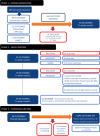Developing a core outcome set for fistulising perianal Crohn's disease
- PMID: 29437911
- PMCID: PMC6352412
- DOI: 10.1136/gutjnl-2017-315503
Developing a core outcome set for fistulising perianal Crohn's disease
Abstract
Objective: Lack of standardised outcomes hampers effective analysis and comparison of data when comparing treatments in fistulising perianal Crohn's disease (pCD). Development of a standardised set of outcomes would resolve these issues. This study provides the definitive core outcome set (COS) for fistulising pCD.
Design: Candidate outcomes were generated through a systematic review and patient interviews. Consensus was established via a three-round Delphi process using a 9-point Likert scale based on how important they felt it was in determining treatment success culminating in a final consensus meeting. Stakeholders were recruited nationally and grouped into three panels (surgeons and radiologists, gastroenterologists and IBD specialist nurses, and patients). Participants received feedback from their panel (in the second round) and all participants (in the third round) to allow refinement of their scores.
Results: A total of 295 outcomes were identified from systematic reviews and interviews that were categorised into 92 domains. 187 stakeholders (response rate 78.5%) prioritised 49 outcomes through a three-round Delphi study. The final consensus meeting of 41 experts and patients generated agreement on an eight domain COS. The COS comprised three patient-reported outcome domains (quality of life, incontinence and a combined score of patient priorities) and five clinician-reported outcome domains (perianal disease activity, development of new perianal abscess/sepsis, new/recurrent fistula, unplanned surgery and faecal diversion).
Conclusion: A fistulising pCD COS has been produced by all key stakeholders. Application of the COS will reduce heterogeneity in outcome reporting, thereby facilitating more meaningful comparisons between treatments, data synthesis and ultimately benefit patient care.
Keywords: anal sepsis; clinical trials; crohn’s disease; ibd.
© Article author(s) (or their employer(s) unless otherwise stated in the text of the article) 2019. All rights reserved. No commercial use is permitted unless otherwise expressly granted.
Conflict of interest statement
Competing interests: KS and SOA have received honoraria from Takeda for sitting on an advisory board. PJT has received honoraria from Takeda for sitting on an advisory board and for speaking at a symposium. AJL is an advisory board member or received lecture fees from Takeda Pharma, AbbVie, Vifor Pharma, Dr Falk and Shield Therapeutics. ALH has served as a consultant, advisory board member or speaker for AbbVie, Atlantic, Bristol-Myers Squibb, Celltrion, Falk, Ferring, Janssen, MSD, Napp Pharmaceuticals, Pfizer, Pharmacosmos, Shire and Takeda. She also serves on the Global Steering Committee for Genentech. NSF has received travel grants from Obsidian Health and Strategen to deliver invited lectures.
Figures
References
-
- Silverberg MS, Satsangi J, Ahmad T, et al. . Toward an integrated clinical, molecular and serological classification of inflammatory bowel disease: report of a Working Party of the 2005 Montreal World Congress of Gastroenterology. Can J Gastroenterol 2005;19 Suppl A:5A–36. 10.1155/2005/269076 - DOI - PubMed
Publication types
MeSH terms
Grants and funding
LinkOut - more resources
Full Text Sources
Other Literature Sources
Medical


